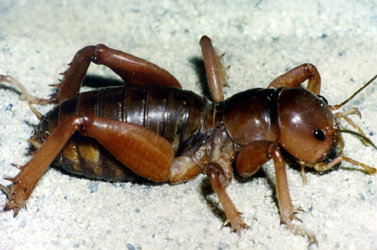|
| Query: ground beetle | Result: 67th of 92 | |
Jerusalem Cricket (Family: Stenopelmatidae, Genus: Stenopelmatus) - Wiki
| Subject: | Jerusalem Cricket (Family: Stenopelmatidae, Genus: Stenopelmatus) - Wiki
| |

| Resolution: 377x250
File Size: 55423 Bytes
Upload Date: 2007:09:25 07:57:11
|
Jerusalem cricket
From Wikipedia, the free encyclopedia
[Photo] Mahogany Jerusalem cricket, from http://www.werc.usgs.gov/sandiego/jerusalem-crickets.html Photo by David Weissman
Jerusalem crickets (genus Stenopelmatus) are a group of large, flightless insects native to western United States, along the Pacific Coast, and south into Mexico. Because of their large, human-like head, they are commonly called ni??o de la tierra (Spanish for "child of the earth"), Earth baby, cara de ni??o (Spanish for "child's face"), or w?? see ts'inii (Navajo for "skull insect"). They are also often called potato bugs or alternatively the old bald-headed man.
Despite their name, Jerusalem crickets are neither true crickets nor true bugs and do not prefer potatoes for food. Active both day and night the insects use their strong mandibles to feed primarily on dead organic material but can also eat other insects. Their highly adapted feet are used for burrowing beneath moist soil to feed on decaying root plants and tubers.
Classification
There are a few other genera in the family Stenopelmatidae, that occur in other parts of the world, but these are very similar to Stenopelmatus in most respects.
Order: Orthoptera
Family: Stenopelmatidae
Genus: Stenopelmatus
Species
Stenopelmatus coahuilensis
Stenopelmatus fuscus
Stenopelmatus intermedius
Stenopelmatus longispina
Stenopelmatus mescaleroensis
Stenopelmatus navajo
Stenopelmatus nigrocapitatus
Stenopelmatus pictus
plus numerous unnamed species (>30)
Song
Similar to true crickets, each species of Jerusalem cricket produces a different song during mating, but this "song" takes the form of a characteristic drumming in which the insect beats its abdomen against the ground. Most species have no sound-producing structures, and evidently none have structures they could use to hear audible sound (true crickets use their wings to produce sounds, but Stenopelmatus lack wings, and crickets and katydids have membranous "ears" they use to hear) - they do not even seem to be able to hiss by forcing air through their spiracles, as some beetles and cockroaches do. Instead, the few Jerusalem crickets which do make audible sound rub their hind legs against the sides of the abdomen, which produces a rasping, "hissing" noise; this rasping noise appears to be designed to frighten predators, rather than being used in communication between the crickets themselves. For such purposes, Jerusalem crickets apparently rely exclusively on substrate vibrations, which are felt rather than heard.
Common Myths
As is true for other large, "ugly" arthropods (e.g. solpugids), there are a number of folk tales regarding Jerusalem crickets which are simply untrue; first and foremost, they are not venomous. However, they can emit a foul smell and are capable of inflicting a painful bite - but neither is lethal, as some of the tales would suggest. They also do not cry like children, nor rub their legs together to make sounds.
http://en.wikipedia.org/wiki/Jerusalem_cricket
| The text in this page is based on the copyrighted Wikipedia article shown in above URL. It is used under the GNU Free Documentation License. You may redistribute it, verbatim or modified, providing that you comply with the terms of the GFDL. |
|
^o^
Animal Pictures Archive for smart phones
^o^
|
|